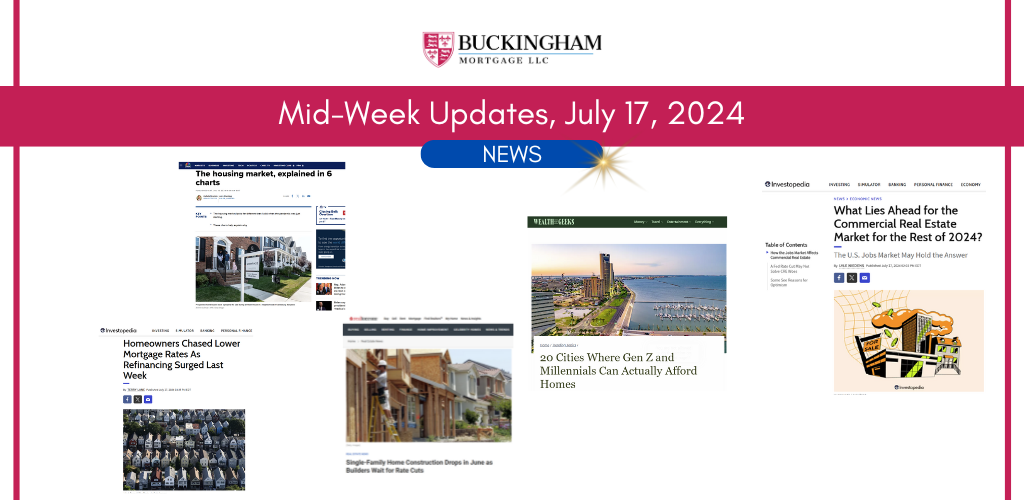✅Mid-Week News Updates, July 17, 2024
in
News

Mid-Week Updates, July 17, 2024
➡️Single-Family Home Construction Drops in June as Builders Wait for Rate Cuts
Construction activity on single-family homes dropped for the fourth straight month in June, as high interest rates weighed on building activity. Single-family housing starts were at a seasonally adjusted annual rate of 980,000 last month, down 2.2% from May, according to U.S. Census data released on Wednesday. Permits for single-family homes also dropped 2.3% on the month, to a rate of 934,000. Overall housing starts rose in June, driven by a 19% monthly increase in multifamily units, which are more volatile from month to month. Multifamily starts jumped to a four-month high of 373,000 annualized. The slowdown in single-family home construction comes as higher interest rates weigh on both homebuyers and builders. Still, the level of newly built homes for sale is at its highest since fall 2022, as measured by months of inventory at current sales paces. The U.S. had 9.3 months of inventory of new homes for sale in May, according to census data, compared with a total market inventory of 4.4 months. Six months of inventory is considered a balanced market, indicating the outsized role new construction plays in the current housing market, experts say.
More here: Single-Family Home Construction Drops in June as Builders Wait for Rate Cuts (realtor.com)
➡️Homeowners Chased Lower Mortgage Rates As Refinancing Surged Last Week
Refinancing surged last week as many homeowners took advantage of a drop in mortgage rates to pay less interest on their existing home loans. The average 30-year, fixed-rate mortgage dropped to 6.87% last week, its lowest rate since March, according to the Mortgage Bankers Association (MBA).1 That drove refinancing to its highest level since August 2022, according to the MBA’s weekly mortgage application index. High interest rates have stymied over the past two years. Potential buyers have been pushed to the sidelines by high monthly payments. Sellers have hesitated to list their homes for sale and trade in the ultra-low mortgage rates of years past.
More here: Homeowners Chased Lower Mortgage Rates As Refinancing Surged Last Week (investopedia.com)
➡️What Lies Ahead for the Commercial Real Estate Market for the Rest of 2024?
The decline of the commercial real estate market began as offices sat empty after pandemic-era restrictions and amid a slower-than-expected return to office for workers. As of the first quarter, growth in office jobs dating to 2022 had increased at just a third of the rate of overall employment growth.
One-fifth of all U.S. offices stood vacant in the first quarter of this year, the highest percentage in history. Office construction has declined 63% since the pandemic. A resilient labor market has helped limit the damage. “Along with interest rates, job growth is probably the single biggest driver of growth in the real estate market,” said Richard Barkham, global chief economist with property manager CBRE. A cooling jobs market could prompt the Fed to cut high interest rates, which would reduce borrowing costs for commercial buyers and boost investor sentiment. However, if the central bank is pressed to cut rates because the jobs situation has deteriorated significantly, the commercial real estate market would likely suffer.
More here: What Lies Ahead for the Commercial Real Estate Market for the Rest of 2024? (investopedia.com)
➡️20 Cities Where Gen Z and Millennials Can Actually Afford Homes
Despite what the headlines tell us, owning a starter home isn’t impossible for Gen Z and Millennials. In the South and Midwest, young adults aged 25 – 34 actually have a shot at buying affordable homes. The best cities for home buying were determined by Point2Homes based on income, job opportunities, homeownership rates, price inflation, and housing inventory. Here are 20 cities — not empty ghost towns in the middle of nowhere — younger people can afford.
More here: 20 Cities Where Gen Z and Millennials Can Actually Afford Homes – Wealth of Geeks
➡️What happens to the housing market when mortgage rates finally come down?
Is it darkest before the dawn? If we look at the housing market right now, sales are down, new listings are down, and prices are decelerating. But if we look at the data right now, things look the most bullish they’ve been all year. Good inflation data came in last week, the bond market rallied, and mortgage rates took a notable dip below 7% for the first time in months. Maybe we’re finally past the peak of mortgage rates? If so, how should we expect the housing market to react? We’ll dive into those questions when we look at this week’s latest numbers.
More here: What happens to the housing market when mortgage rates finally come down? – HousingWire
➡️The housing market, explained in 6 charts
It’s no secret that the housing market looks far different than it did a few years ago.
While surging mortgage rates and housing prices have taken away consumers’ purchasing power, low supply has kept the market competitive. As a result, affordability has tumbled dramatically from the early days of the pandemic. These six charts help explain what this unique moment looks like — and what it means for you: The 30-year mortgage rate, a popular option for home buyers utilizing financing, is key to understanding the market. This rate is essentially the borrowing costs tied to purchasing a home with financing. A higher rate, in reality, results in more interest due on a home loan. For the past several months, this rate has hovered around the 7% level. While it has cooled after touching 8% late last year, it’s still far higher the sub-3% rates consumers could lock in during the first years of the pandemic.
More here: The housing market, explained in 6 charts (cnbc.com)
